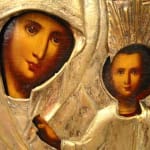The Mother of God of Kazan, 19th Century CE
Oklad/Oil on Wood
12
PF.5784
Inseparable from the liturgical tradition, religious art is seen by Orthodox Christians as a form of pictorial confession of faith and a channel of religious experience. Because icons provide direct...
Inseparable from the liturgical tradition, religious art is seen by Orthodox Christians as a form of pictorial confession of faith and a channel of religious experience. Because icons provide direct personal contact with the holy persons represented on them, these images were objects of veneration, in either a public or private setting, and were even believed to have the ability to heal.
The naturalistic technique of painting in this icon is uncommon is Russian Orthodox art which mainly derives its influence from older Byzantine icons and mosaics. What is most impressive about this painting is the stunning beauty and warmth of the painted flesh, considering that the majority or the composition is covered in a gilded brass oklad. A repoussé technique in high relief has been utilized to achieve the folds and curves of the figures’ robes. The metal has also been engraved, depicting the floral patterns of the Virgin’s drapery. A motif in relief of intertwining flowers as well as geometric patterns fills the borders of the oklad. A separate piece of metal has been attached just above the holy figures’ heads to serve as their halos. Both mother and child gaze out at us. The infant Christ raises his hand in a sign of benediction. We are drawn to the natural warmth of the figures. Although divine in nature, they have been humanized so that we can identify with them. This icon serves to bring the viewer closer to God through the veneration of Christ and Mary, the Mother of God.
The naturalistic technique of painting in this icon is uncommon is Russian Orthodox art which mainly derives its influence from older Byzantine icons and mosaics. What is most impressive about this painting is the stunning beauty and warmth of the painted flesh, considering that the majority or the composition is covered in a gilded brass oklad. A repoussé technique in high relief has been utilized to achieve the folds and curves of the figures’ robes. The metal has also been engraved, depicting the floral patterns of the Virgin’s drapery. A motif in relief of intertwining flowers as well as geometric patterns fills the borders of the oklad. A separate piece of metal has been attached just above the holy figures’ heads to serve as their halos. Both mother and child gaze out at us. The infant Christ raises his hand in a sign of benediction. We are drawn to the natural warmth of the figures. Although divine in nature, they have been humanized so that we can identify with them. This icon serves to bring the viewer closer to God through the veneration of Christ and Mary, the Mother of God.



